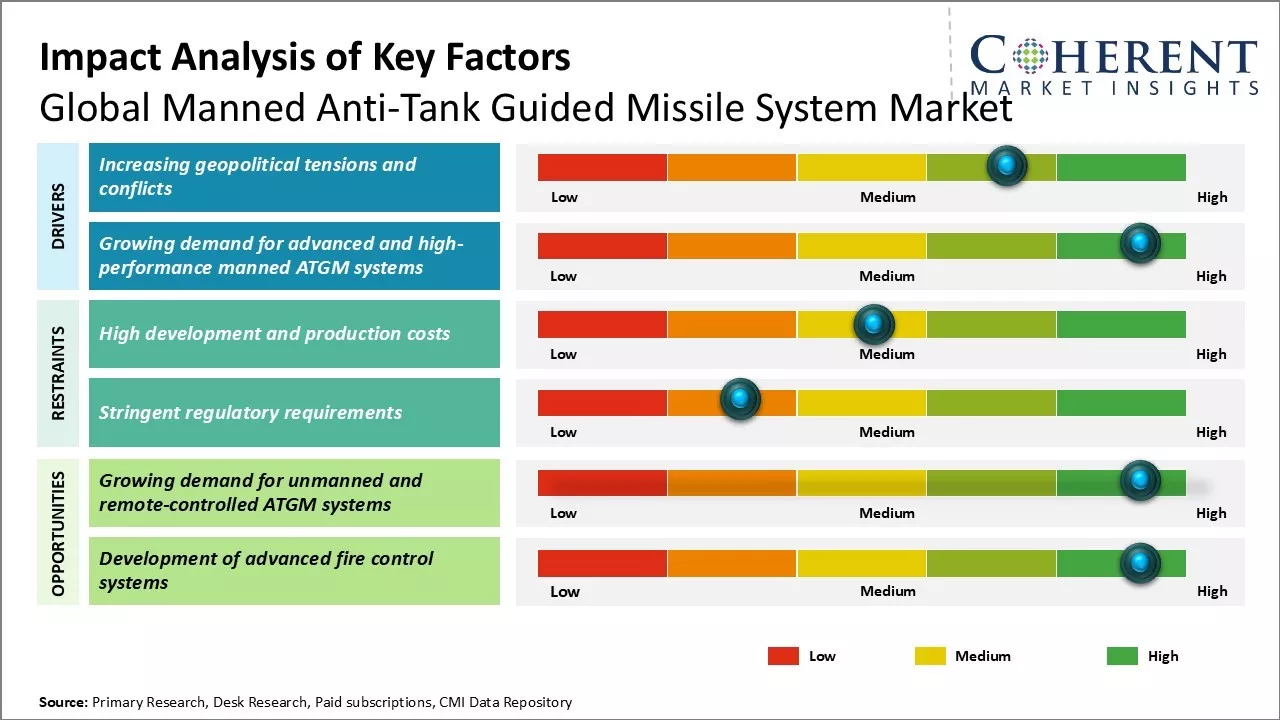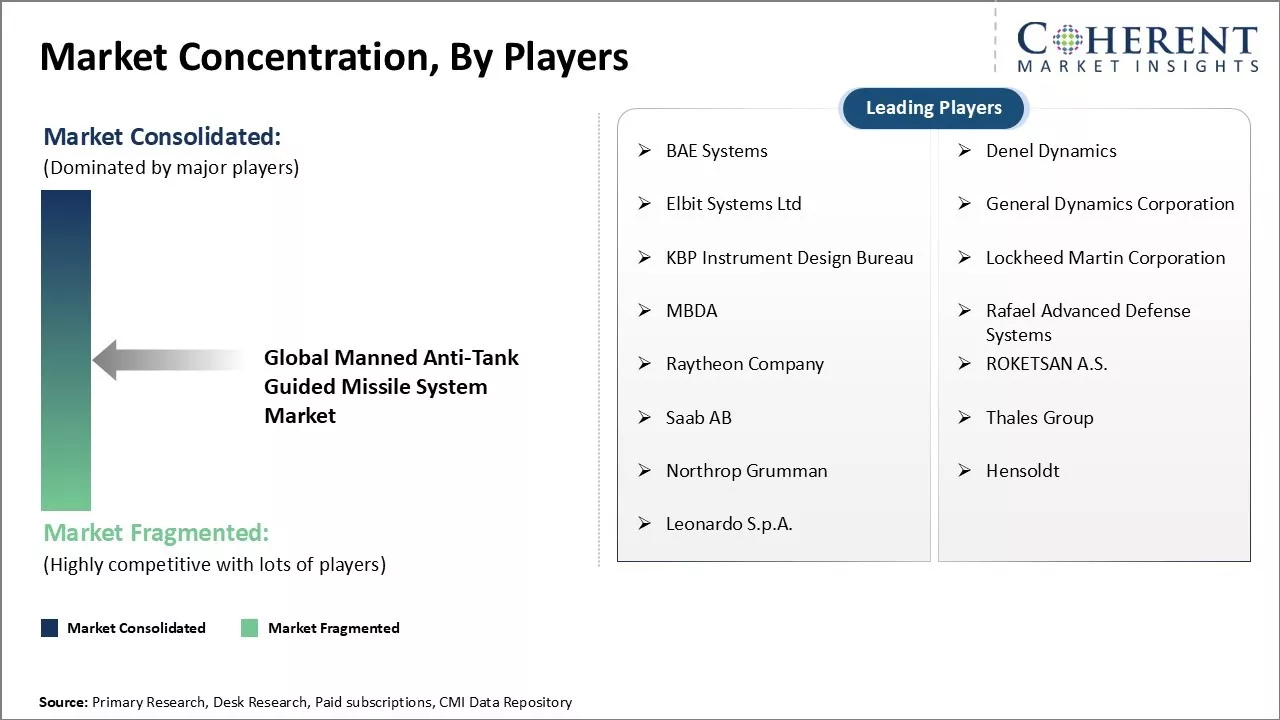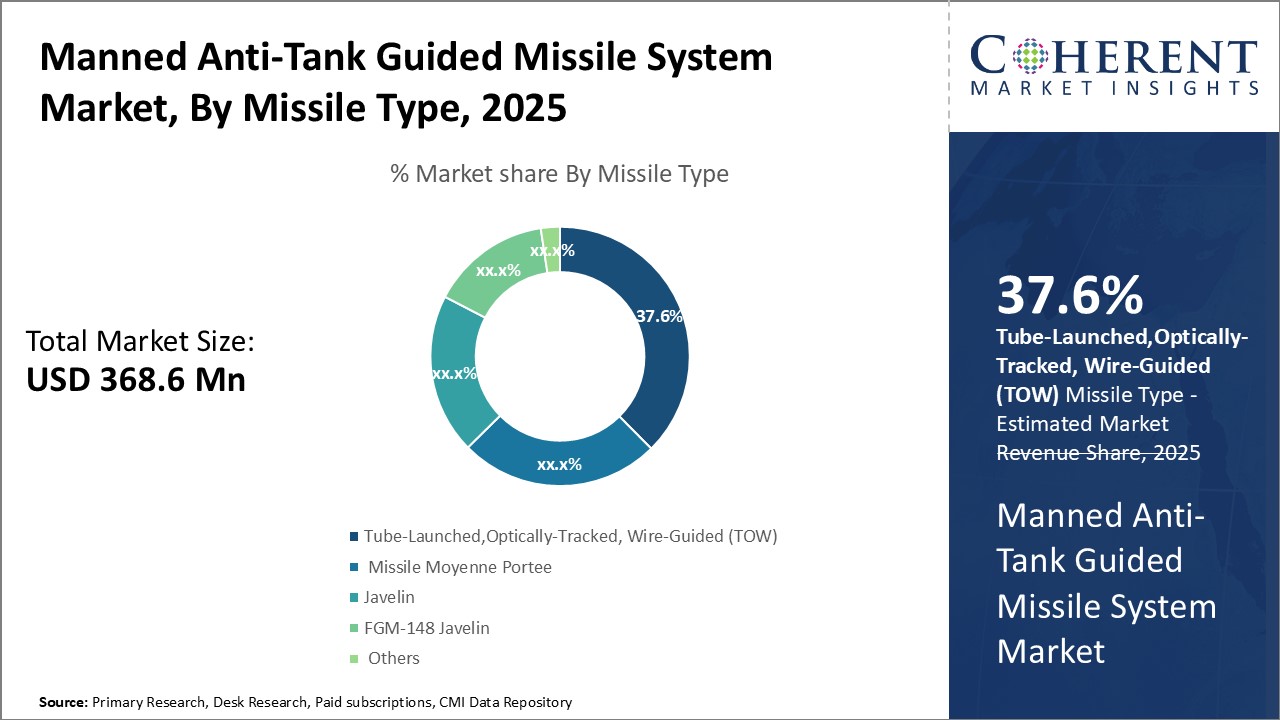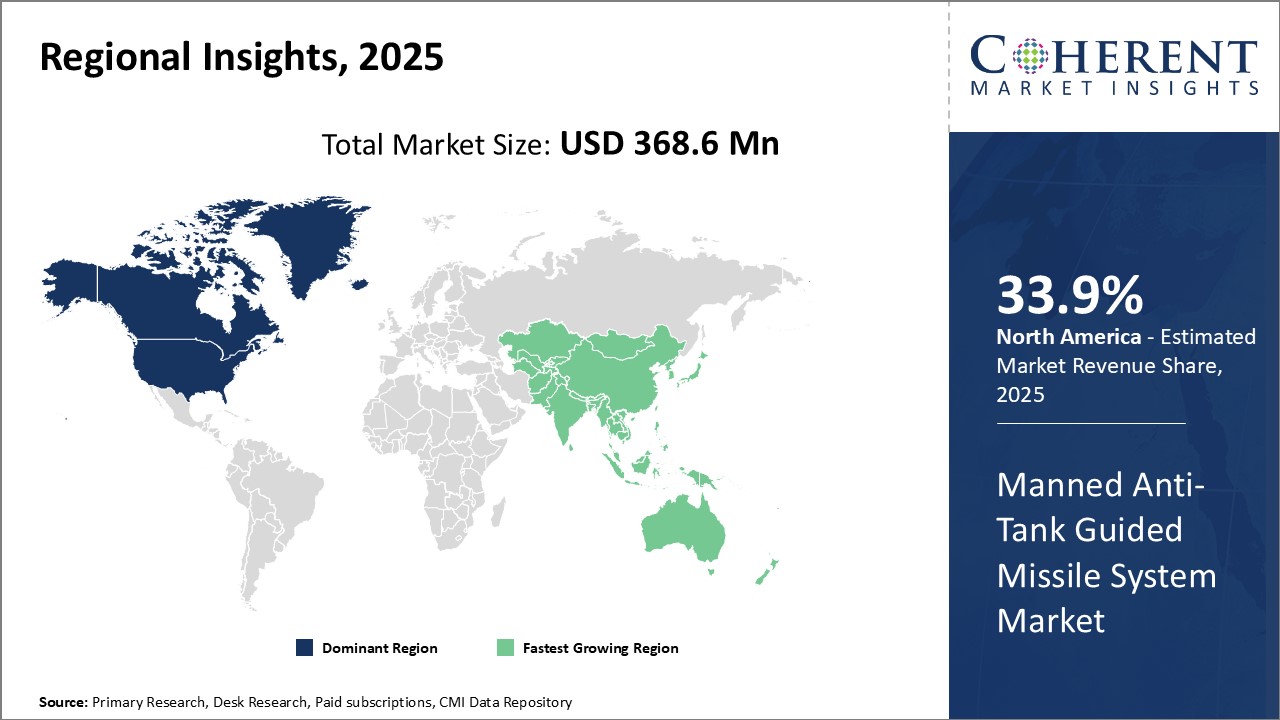Manned Anti-Tank Guided Missile System Market Size and Trends
The Global Manned Anti-Tank Guided Missile System Market is estimated to be valued at USD 368.6 Mn in 2025 and is expected to reach USD 502.0 Mn by 2032, exhibiting a compound annual growth rate (CAGR) of 4.5% from 2025 to 2032.

Discover market dynamics shaping the industry: Download Free Sample
The manned anti-tank guided missile system market is expected witness substantial growth over the forecast period. Key factors such as increasing defense budgets and rising threats from militant and extremist groups are expected to drive demand. Additionally, technological advancements including improved targeting systems and miniaturization are anticipated to boost adoption. However, high costs associated may limit market expansion to some extent. Nonetheless, growing conflicts worldwide are likely to continue creating opportunities for manned anti-tank guided missile manufacturers in the coming years.
Increasing geopolitical tensions and conflicts
As geopolitical tensions continue to rise around the world, the need for effective manned anti-tank guided missile (ATGM) systems is growing. Various territorial disputes and conflicts over borders have heightened threats of military confrontation in several regions. With advancing militarization by adversaries, countries feel compelled to bolster their defenses against armored assaults.
Manned ATGMs allow soldiers to precisely engage enemy tanks from concealed positions at ranges beyond most other portable anti-armor weapons. Their advanced fire-and-forget capabilities combined with top-attack munitions offer a potent solution against even the most modern battle tanks. As border tensions escalate into occasional skirmishes involving armored vehicles, the strategic value of these systems rises substantially. Their deployment acts as a deterrent in disputes and provides key support in repelling hostile mechanized thrusts if conflict does break out.
While open conflict is still avoided, the risks appear high enough to drive investments in advanced ATGMs. Their long-range precision hits against moving targets allow engaging enemy formations from stand-off distances with tactical surprise. This strengthens defensive postures amid threats and doubts over diplomatic de-escalation.
For instance, in March 2021, the Indian Army signed a contract worth US$ 14.15 Mn with Bharat Dynamics Limited (BDL), a state-owned defense manufacturer under the Ministry of Defence, for the supply of 4,960 anti-tank guided missiles. The deal will equip the Army with Milan-2T missiles, a tandem warhead ATGM with a range of 1,850 meters, capable of being fired from both ground and vehicle-mounted launchers. This acquisition will significantly enhance the Army's anti-tank firepower and defensive capabilities.
Market Concentration and Competitive Landscape

Get actionable strategies to beat competition: Download Free Sample
Growing Demand for Advanced and High-Performance Manned ATGM Systems
End Users in the defense sector regularly evaluate their weapons stockpiles for upgrades that deliver tactical advantages against evolving threats. Manned ATGMs have emerged as a system of choice due to their unparalleled tank-killing performance backed by autonomous and lock-on fire modes. However, earlier manned launchers and missiles lacked the technical sophistication demanded in current battlefields characterized by integrated sensors, networked communications and automated targeting solutions.
This has spurred extensive research into new manned ATGM configurations with augmented targeting systems, multi-role capabilities, extended ranges and all-weather operability. Modern digitized technologies assist soldiers in acquiring targets day or night through thermal sights, automatically correcting aim points based on real-time data links. Multi-warhead missiles dramatically increase the odds of detonating within explosive reactive armor suites which have reduced single-warhead ATGM effectiveness. Top-attack trajectories make tanks vulnerable from their thinnest top armor using tandem-charge warheads.
Special forces have also recognized the untapped potential of manned ATGMs for precise ambushes and counterattacks behind enemy lines. Lighter portable missiles launched from concealed firing positions can significantly boost infantry firepower on strategic raids. Their large destructive potential in a compact package gives isolated troops and armor-killing option during infiltration missions. This has spurred research at defense agencies towards specialized man-packable ATGM variants with advanced optical triangulation for covert engagements.
The demand hence stems from pressing military needs across multiple environments and operational scenarios. End-users want solutions capable of combining tactical agility with overwhelming terminal effects on any known or future tank variants. This drive continued product evolution in warhead designs, multi-spectral seekers, active protection countermeasures and modular launch platforms optimized for various mission profiles.
Key Takeaways from Analyst:
The global manned anti-tank guided missile system market is poised to grow steadily driven by increasing defense budgets of major economies. Armed forces across the world are procuring advanced missile systems to strengthen their ground defense capabilities against enemy tanks. Ongoing border conflicts and rising geopolitical tensions have heightened the need to deter land attacks. Additionally, the modernization of armed forces with latest technology is another key factor fueling demand in both developed and developing regions.
However, high procurement and maintenance costs of these systems could restrict growth to some extent. Also, global economic slowdown due to the pandemic may cause defense budget cuts impacting short term purchases. Nonetheless, long term demand looks robust as more nations look to replace aging fleets. North America currently dominates aided by the U.S. army's conversion to shoulder-fired missiles. Europe is also a major market with strong focus on military modernization. Asia Pacific is poised to be the fastest growing area led by Indian and Chinese spending.
New product development focusing on advanced technologies including artificial intelligence, extended range and lightweight missiles could open up new opportunities. Integration of these systems on ground and air defense platforms enhances mobility and effectiveness on the battlefield. Collaborations between private manufacturers and armed forces will be crucial to fulfil customized requirements of different projects.
Market Challenge - High development and production costs
One of the major challenges for the global manned anti-tank guided missile system market is the high development and production costs associated with these systems. Developing cutting edge technology for missile guidance, target acquisition and homing requires significant investments in R&D. Additionally, integrating these complex systems onto manned platforms like vehicles and helicopters adds to the engineering challenges and costs. With defence budgets under pressure globally, convincing military customers to invest in such expensive systems is difficult. Manufacturers have to charge high prices to recover their investments which impacts sales. Strict export controls also limit the potential market size for many manufacturers. To address this, companies need to focus on achieving greater commonality, modularity and reuse of components across different manned ATGM systems to reduce per unit costs over time. There is scope to exploit economies of scale through international co-production partnerships as well.
Market Opportunity - Growing demand for unmanned and remote-controlled ATGM systems
One of the major opportunities for the global manned anti-tank guided missile system market is the growing demand for unmanned and remote-controlled ATGM systems. With advancement in autonomous technologies, many militaries are opting for replacing manned ATGM vehicles and helicopters with unmanned aerial and ground-based platforms for improved safety, endurance, and cost effectiveness. This reduces the life-cycle costs significantly by avoiding costs associated with training crews and medical insurance. Unmanned systems also offer advantages like 24x7 operations, optional manning, and reduced sensor signatures. Their adoption is increasing for counter insurgency and border security roles.

Discover high revenue pocket segments and roadmap to it: Download Free Sample
Insights By Missile Type - Dependable and Cost-Effective Tactics Drive TOW Missiles
In terms of Missile Type, the Tube-Launched, Optically-Tracked, Wire-Guided (TOW) segment is estimated to hold the highest share of the market owing to its dependability and cost-effectiveness. The TOW missile has been in service for over 40 years, proving itself a versatile weapon on land and at sea. Its wired-guidance system allows soldiers to guide the missile to its target from up to 3.75 km away, granting more precision and control than other optically-tracked systems while avoiding potential signal interference. Repairing and refurbishing the TOW is also straightforward for military technicians. With over 750,000 missiles produced for different service branches, the high production volume has kept unit prices low - important for financially constrained defense budgets. Several TOW variants expand its capabilities against armored vehicles as well as improvised fortifications increasingly used by unconventional forces. Overall, the TOW satisfies requirements for an affordable yet consistently reliable anti-tank solution.
Insights By Firing Platform - Vehicle-Mounted Platforms Consolidate Firepower
In terms of Firing Platform, the Vehicle-Mounted segment is estimated to hold 63% share of the market as it consolidates anti-tank firepower around mechanized units. Vehicle platforms boost soldiers' mobility and safety by keeping them outside of immediate danger zones. Mounting missiles on amphibious Armored Personnel Carriers or light tactical vehicles gives maneuver elements concentrated anti-armor effect from a protected firing position. Coordination with accompanying infantry. This force multiplication is crucial in contested environments where tanks and fighting vehicles must breach enemy defenses. Vehicle launching also streamlines complex firing sequences into automated processes controlled from within the protected shelter. As armored assaults become more joint inter-arms affairs, dedicated vehicle launchers help anti-tank teams "stay in the fight" as integral parts of combined-arms formations.
Insights By End User - Military Dominance Derives from Combat Realities
In terms of End User, the Military segment is estimated to hold 60.3% share owing to frontline combat realities. Anti-tank weapons remain fundamental to counter enemy armor on modern battlefields. As attrition rises and territorial conflicts intensify, armed forces must overcome tanks and fortified positions that can block missions and endanger troops. Manned missile systems strengthen infantry’s defensive abilities while also driving offensives through concentrated direct fire. Their integration with main battle tanks and mechanized units as ‘hunter-killer’ teams is now standard battlefield doctrine. Military leadership additionally values manned launchers for training soldiers in core skills applicable across diverse weapons. Though security threats evolve, tanks will stay potent tools of strategic coercion that armed forces must technically and tactically match. Ensuring dominant anti-armor capabilities thus remains central to demonstrating military credibility and accomplishing national defense priorities.
Regional Insights

Need a Different Region or Segment? Download Free Sample
The North American region currently dominates the global manned anti-tank guided missile system market with an estimated 33.9% share in 2025 owing to the strong presence of key players in the U.S. American companies such as Lockheed Martin, Raytheon, and Northrop Grumman have decades of experience in developing leading anti-tank guided missiles for applications of both ground forces and aerial platforms. The defense budgets of the U.S. and Canada are substantially high which enables continual upgrades and modernization of their anti-tank weaponry including manned missile systems. These countries also have robust manufacturing infrastructure and supply chains to support production of varied anti-tank missile variants on large scales.
The Asia Pacific region has emerged as the fastest growing regional market for manned anti-tank guided missile systems. Countries like India and China are aggressively indigenizing their missile programs which augments regional business prospects. Export orders from other Asian and Middle Eastern countries additionally spurs demand from this region. For instance, China has been actively exporting its HJ-10 and HJ-12 missiles which extends its market influence. Procurement programs in Asia Pacific also incorporate advanced Western systems through government-to-government deals, providing opportunities to global anti-tank firms. Pricing of Asian manufactured missiles tends to be comparatively affordable increasing their appeal amongst emerging economies and armed forces with smaller budgets.
Developing precision strike abilities against enemy armor is pivotal for the military strategies of several APAC nations considering modern warfare trends and conflicts in their vicinity. Local system integrators and defense majors collaborate extensively with global prime contractors to strengthen indigenous R&D and qualify their missiles through rigorous testing protocols. This develops the region's self-sufficiency while stimulating associated spending on manned missile systems and lifecycle support services. Overall, the Asia Pacific region is witnessing intensifying requirements for these solutions in line with its financial capabilities and evolving defense priorities against threats.
Market Report Scope
Manned Anti-Tank Guided Missile System Market Report Coverage
| Report Coverage | Details | ||
|---|---|---|---|
| Base Year: | 2024 | Market Size in 2025: | USD 368.6 Mn |
| Historical Data for: | 2020 To 2024 | Forecast Period: | 2025 To 2032 |
| Forecast Period 2025 to 2032 CAGR: | 4.5% | 2032 Value Projection: | USD 502.0 Mn |
| Geographies covered: |
|
||
| Segments covered: |
|
||
| Companies covered: |
BAE Systems, Denel Dynamics, Elbit Systems Ltd, General Dynamics Corporation, KBP Instrument Design Bureau, Lockheed Martin Corporation, MBDA, Rafael Advanced Defense Systems, Raytheon Company, ROKETSAN A.S., Saab AB, Thales Group, Northrop Grumman, Hensoldt, and Leonardo S.p.A. |
||
| Growth Drivers: |
|
||
| Restraints & Challenges: |
|
||
Uncover macros and micros vetted on 75+ parameters: Get instant access to report
Manned Anti-Tank Guided Missile System Industry News
- In July 2024, VezoPay, a leading innovator in payment technology, introduced Africa's first smart ring, marking a significant advancement in contactless payment solutions across the continent. Designed for both convenience and security, the VezoPay smart ring showcases a range of cutting-edge features that epitomize the future of digital transactions.
- In September 2022, the Slovenian Ministry of Defense awarded a contract worth USD 6.6 million to EuroSpike, a joint venture specializing in advanced missile systems, to supply 50 Spike LR2 Long-range Anti-tank Guided Missiles (ATGMs) for the country. These systems are set to be mounted on Oshkosh's Joint Light Tactical Vehicles (JLTV), enhancing Slovenia's defense capabilities.
- In February 2021, as part of collaborative user testing, the Indian Army and Air Force conducted a series of launches involving four HELINA anti-tank missiles from an Advanced Light Helicopter (ALH) Dhruv in the Rajasthan sector. The tests aimed to evaluate the missile's capabilities at both minimum and maximum ranges of seven kilometers, culminating in a final mission where a warhead missile successfully destroyed a derelict tank. The HELINA missile, developed by the Defence Research and Development Organisation (DRDO), is recognized for its advanced technology and effectiveness in modern warfare.
- In March 2021, the Indian Army will receive 4,960 anti-tank guided missiles from Bharat Dynamics Limited (BDL), a leading public sector defense manufacturing company under the Ministry of Defence, Government of India. The Rs 1,188 crore contract will provide the Army with missiles capable of being launched from both ground and vehicle-mounted launchers, with an effective range of 1,850 meters, bolstering its anti-tank capabilities.
*Definition: The Global Manned Anti-Tank Guided Missile System Market involves systems that are operated by individuals and intended to target and destroy enemy tanks and other armored fighting vehicles. These systems allow soldiers to manually guide anti-tank missiles to their targets from portable launchers, providing precise engagement capabilities from a distance against armored threats on land.
Market Segmentation
- By Missile Type Insights (Revenue, USD Mn, 2020 - 2032)
- Tube-Launched, Optically-Tracked, Wire-Guided (TOW)
- Missile Moyenne Portée (MMP)
- Javelin
- FGM-148 Javelin
- Others
- By Firing Platform Insights (Revenue, USD Mn, 2020 - 2032)
- Vehicle-Mounted
- Man-Portable
- By End User Insights (Revenue, USD Mn, 2020 - 2032)
- Military
- Homeland Security
- Regional Insights (Revenue, USD Mn 2020 - 2032)
- North America
- U.S.
- Canada
- Latin America
- Brazil
- Argentina
- Mexico
- Rest of Latin America
- Europe
- Germany
- U.K.
- Spain
- France
- Italy
- Russia
- Rest of Europe
- Asia Pacific
- China
- India
- Japan
- Australia
- South Korea
- ASEAN
- Rest of Asia Pacific
- Middle East
- GCC Countries
- Israel
- Rest of Middle East
- Africa
- South Africa
- North Africa
- Central Africa
- North America
- Key Players Insights
- BAE Systems
- Denel Dynamics
- Elbit Systems Ltd
- General Dynamics Corporation
- KBP Instrument Design Bureau
- Lockheed Martin Corporation
- MBDA
- Rafael Advanced Defense Systems
- Raytheon Company
- ROKETSAN A.S.
- Saab AB
- Thales Group
- Northrop Grumman
- Hensoldt
- Leonardo S.p.A.
Share
Share
About Author
Suraj Bhanudas Jagtap is a seasoned Senior Management Consultant with over 7 years of experience. He has served Fortune 500 companies and startups, helping clients with cross broader expansion and market entry access strategies. He has played significant role in offering strategic viewpoints and actionable insights for various client’s projects including demand analysis, and competitive analysis, identifying right channel partner among others.
Missing comfort of reading report in your local language? Find your preferred language :
Transform your Strategy with Exclusive Trending Reports :
Frequently Asked Questions
EXISTING CLIENTELE
Joining thousands of companies around the world committed to making the Excellent Business Solutions.
View All Our Clients
